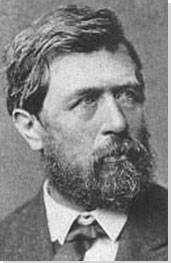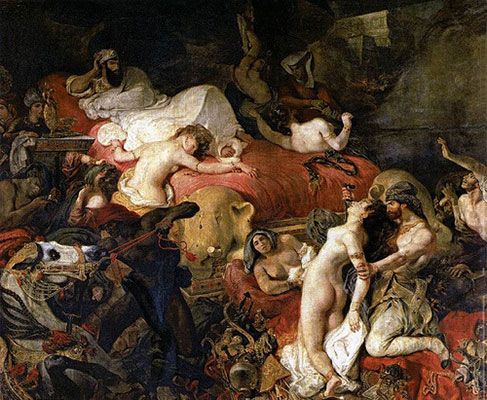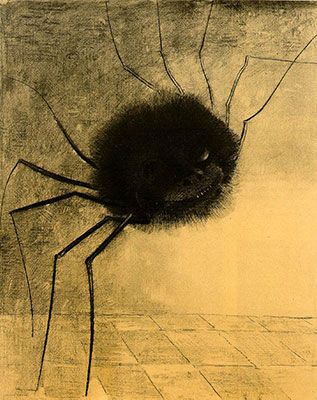Summary of Arnold Böcklin
Arnold Böcklin is unusual amongst modern artists in that he was never comfortable with being described as one. While other painters of his era experimented with ever more pronounced forms of abstraction and stylistic experiment, turning their back on the classical and historical subject-matter of the past, Böcklin immersed himself in the history of painting from the Renaissance onwards, drawn to mythological imagery, and to all that was dramatic and extravagant. The resultant body of work combines a whole range of painterly traditions with a stylistic and thematic eclecticism which we might call kitsch. His paintings certainly had the mass popular appeal sometimes associated with that term. But they also became a touchstone for many modern artists, particularly those interested in combining naturalistic representation with bizarre subject-matter.
Accomplishments
- Arnold Böcklin was perhaps the most important Northern-European painter attached to the Symbolist movement, whose primarily bases were in France, Belgium, and Russia. While other painters of that school such as Gustave Moreau and Odilon Redon endowed their allegorical works with a brooding intensity, Böcklin often reworked images from classical myth with a ribald humor, though with macabre undercurrents: an odd mixture of the comic and the nightmarish which made his work popular with Surrealist artists such as Salvador Dalí.
- Böcklin brought an unusually wide variety of influences to bear on his work. Inspired in his youth by the Romantic landscape paintings of Caspar David Friedrich and other Northern-European artists, he flirted with a French Realist style in the 1850s before becoming enamored of the Renaissance tradition, especially the stylistic excesses and melodrama of the Baroque. He combined these influences with an unapologetic Catholicism and whimsical irony which is curiously predictive of the postmodern artistic culture of the late-20th century.
- Böcklin was one of the most successful modern artists of the late nineteenth century in terms of his popularity with the general public, taking advantage of a new market for prints and reproductions of paintings in Germany around that time. Versions of works such as Isle of the Dead and Battle of the Centaurs found their way into middle-class living rooms across the country, seeming to speak to a new German nationalism with their strong sense of melodrama and bombast. Böcklin was thus one of the first modern artists to recognize and operate successfully within a mass market.
Important Art by Arnold Böcklin
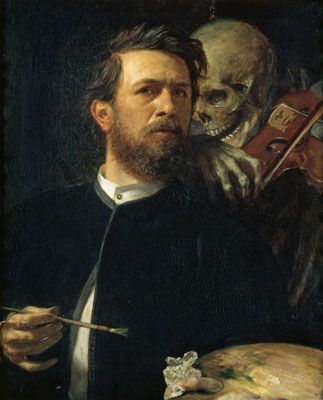
Self-Portrait with Death Playing the Fiddle
In this early, idiosyncratic self-portrait, the artist engages the viewer's gaze almost awkwardly, pausing from his work as if half-sensing the animated skeleton playing the violin behind his left shoulder. The painting demonstrates the gothic humor that would become synonymous with Böcklin's oeuvre, while also suggesting some unexpected creative sources, perhaps especially the Realist painting of mid-nineteenth-century France.
Combining a Romantic, gothic theme with a studied informality of presentation which is especially evident in the artist's posture and clothing - perhaps influenced by the Barbizon painters whom Böcklin had admired in his youth - Böcklin offers us a reworking of the memento mori genre popular since the Northern Renaissance. Hans Holbein the Younger's extraordinary The Ambassadors (1533), and the Portrait of Sir Brian Tuke (1827) also attributed to Holbein, are likely influences; indeed, the latter was on display at the Alte Pinakothek in Munich in the early 1870s, when Böcklin was based in the city. We can also posit a connection to the medieval tradition of the danse macabre, often depicted in woodcuts, showing processions of figures led by dancing skeletons. The piece thus reveals the eclecticism of Böcklin's influences, a trait notable throughout his career.
This painting exerted a significant influence on many subsequent modern artists, notably the German Expressionist painter Lovis Corinth, who created a striking Self-Portrait with Skeleton of his own in 1896. Böcklin's work also inspired the late-romantic composer Gustav Mahler, who, according to his widow Alma, inserted a violin solo on an improperly tuned violin into his Symphony No. 4 in G Major (1900) after seeing the painting.
Oil on canvas, - Alte Nationalgalerie, Berlin
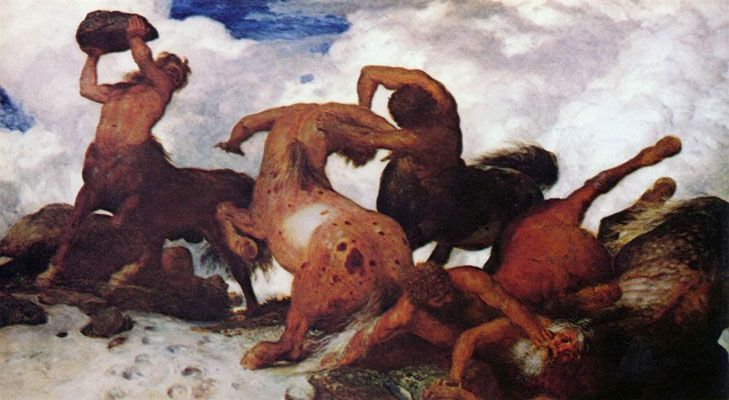
Battle of the Centaurs
Böcklin completed this painting in Munich, where he was based for a time in the early 1870s, working partly in collaboration with his friend, the society painter Franz von Lenbach. Lenbach was then employed by the poet and art collector Adolf Friedrich von Schack, who became a major patron of Böcklin's throughout his career. The work is an explicit homage to Michelangelo's unfinished 1492 marble relief Battle of the Centaurs, but adapts the style of the piece in various ways, responding to various subsequent artistic genres. This is one of many works created by Böcklin which rework the classical mythical tropes of Renaissance Art.
Schack's art collection consisted mainly of copies of Old Masters, as well as original works by living German artists, all hung together in a private gallery. While many artists of Böcklin's era copied from the Old Masters, partly to make a living from collectors such as Shack, Böcklin took a typically frivolous approach to the task, combining a variety of painting traditions in his execution of this work. The melodramatic posturing of the centaurs, for example, seems to owe something to Romantic painting in the tradition of Delacroix, as well as the Baroque influences Böcklin had imbibed in Rome. The warmth of color is reminiscent of German Romantic landscape painters such as Caspar David Friedrich.
Battle of the Centaurs was wildly popular, selling for 6,750 francs in 1876. It was also widely exhibited, and much loved by the German public. The grandeur of the theme and mood perhaps spoke to the German nationalism of the late nineteenth century; one write-up in a contemporary magazine sums up the excitement which the painting aroused in its viewers: "high in a forbidding rocky wilderness, where heaven and earth impinge and clouds hang heavy over cliffs bare of vegetation, evidently in an era when the elemental forces still struggled wildly with one another and the earth was still held in continuous transformation by the forces of fire and water, we see living creatures of this terrible stormy period of our planet's youth who stand in amazing conformance with the Creation emerging from this Chaos."
Oil on canvas - Kunstmuseum, Basel
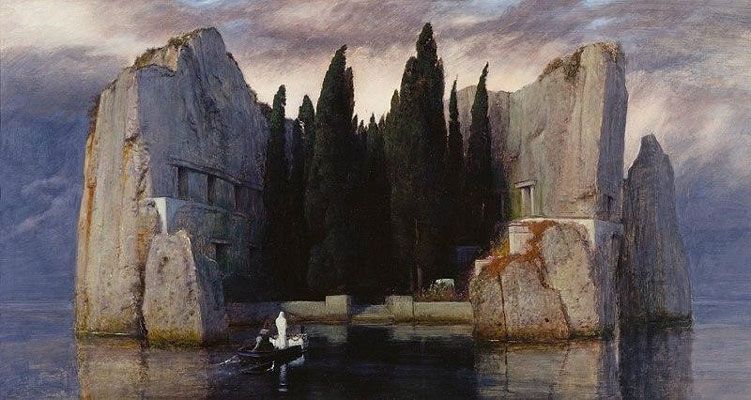
Isle of the Dead
Arnold Böcklin painted five versions of Isle of the Dead between 1880 and 1886. This, the third of them, was created for the art dealer Fritz Gurlitt, who also coined the title for the sequence. Executed in a Romantic style reminiscent of both Symbolist and Pre-Raphaelite painting, it shows two figures, an oarsman and a woman dressed in white, approaching an island in a small rowing boat. The shape at the front of the boat is generally understood to be a coffin, while the island itself is dominated by a grove of cypress trees, with a number of crypt doorways cut into the rock. Isle of the Dead was painted in Florence, and one source for the image was the English Cemetery in that city, located close to where Böcklin buried one of his many children who died in infancy.
The power of this image lies in its thematic and stylistic ambiguity. The source for the scene may be classical - the oarsman is often interpreted as Charon, ferryman of Hades in Greek mythology, transporting his passengers across the River Styx into the underworld - but various real-life models for the island have been suggested, besides the English Cemetery, including St. George Island in Montenegro. The dramatic coloring, and the grandeur of the natural scene, owes much to German Romantic landscape painting, though we can also sense an affinity with the work of the British Pre-Raphaelites, who were much concerned with Arthurian legend, and thus with the mythical Isle of Avalon, depicted in Edward Burn-Jones monumental work The Last Sleep of Arthur in Avalon (1881-98).
Like Battle of the Centaurs, this painting achieved enormous fame in late-nineteenth-century Germany, finding its way into many bourgeois living rooms, and also inspiring the late-Romantic composer Sergei Rachmaninoff's 1908 work Isle of the Dead. With its emphasis on the beauty of nature and the honor of death, it is not surprising that the painting also spoke to German nationalism. Its most infamous owner was Adolf Hitler, who purchased it in 1933, later hanging it in Albert Speer's new Reich Chancellery. However, the image's enigmatic appeal has outlasted the politics for which it was coopted, and the painting continues to be popular in post-unification Germany.
Oil on panel - Alte Nationalgalerie, Berlin
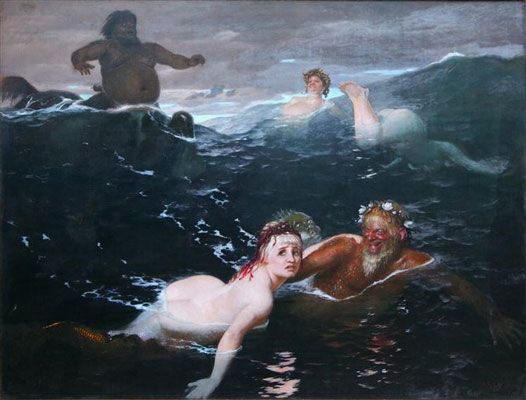
Playing in the Waves
Another painting which had achieved great fame by the time of Böcklin's death, Playing in the Waves shows the artist's irreverent approach to his classical sources. The figures in the waves seem to be modelled on Triton, the sea-god and merman of Greek mythology, but there is no mythical base for the scene depicted. Instead, the painting recalls an incident witnessed by Böcklin during a holiday on the Italian coast, when his friend, the zoologist Anton Dohrn, surprised a group of women bathers, approaching them underwater and suddenly resurfacing. It is even said that the face of the Triton, whose salacious intentions seem clear, is based on Dohrn's.
Despite this seaside-postcard take on Greek mythology, the image is not simply frivolous. The color-palette is dark and melancholic, and the fear on the woman's face seems real enough. The viewer is thus confronted with a strange mixture of sensual, frightful, and humorous energy. The comic-grotesque quality of the painting was noted by many critics during the late nineteenth century, including Cornelius Gurlitt, who expressed the enthusiasm of the German public in general in calling Playing in the Waves "one of the greatest achievements of our century".
The painting's combination of intimate viewing perspective, grand classical allusions, and low comedy, is typical of Böcklin's irreverent approach aesthetic hierarchies and categories, and to his own status as a Neoclassical painter. Prone to moody outbursts, Böcklin is known to have ranted: "to be Greeks! Us? Why were the Greeks Greeks? Because they created what they saw, as seemed right to them. (The ancients did not want to make antiquity, as far as I know - only we want to do that) ... The fresh water of life is what we want, and that is ever flowing for us, as it was for the Greeks. We will only be Greek when we grasp it in our own way." Building on the classical past, Böcklin initiated a whole tradition of the comic-grotesque in subsequent German art, evident in much work of the Expressionist movement.
Oil on canvas - Neue Pinakothek, Munich
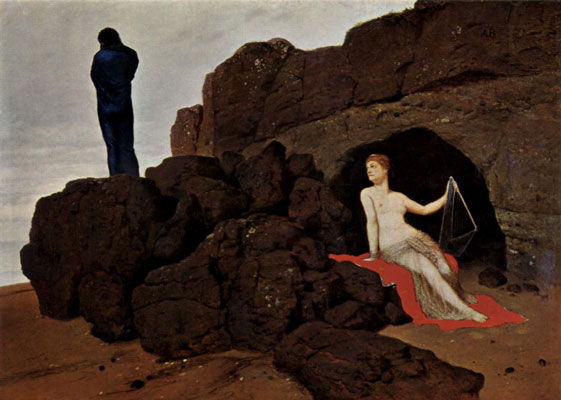
Odysseus and Kalypso
A large part of Böcklin's oeuvre is made up of seascapes, many of them reinterpreting classical motifs with the ribald energy of Peter Paul Rubens, whose fleshy nudes - as in works like The Union of Earth and Sea (1618) - probably influenced paintings of Böcklin's such as Playing in the Waves and In the Sea (1883). In works such as Odysseus and Kalypso, however, Böcklin presents us with a more mournful, enigmatic image. In Homer's Odyssey, the nymph Calypso hypnotizes the hero Odysseus with her music, before detaining him on her island for seven years, first as her lover and then as her prisoner, as Odysseus comes to pine for his home and his wife Penelope. In Böcklin's representation of the story, Calypso plays her lyre in the foreground, gazing anxiously up at Odysseus, who seems to be staring out to see.
The mood of this piece is more somber and mysterious than much of Böcklin's work. The dark mass of rock at the center of the frame means that in visual terms, gloom and shadow dominate the scene while the physical and implied emotional detachments of the two characters suggests feelings of anxiety and isolation. The blue veil draped across the warrior's body, and the concealment of his face, as well as his oddly rigid pose, grant him something of the static quality of the rock surrounding him, as if the figure might not be quite human. The painting's impression of psychological intensity is enhanced by these subtly surreal aspects of its composition.
Works such as Odysseus and Calypso thus reveal why Böcklin's painting was so influential on twentieth-century artists such as the Metaphysical painter Giorgio de Chirico - who often placed isolated figures and statues in strange, desolate landscapes - as well as Surrealists such as Salvador Dalí and Max Ernst.
Oil on panel - Kunstmuseum, Basel
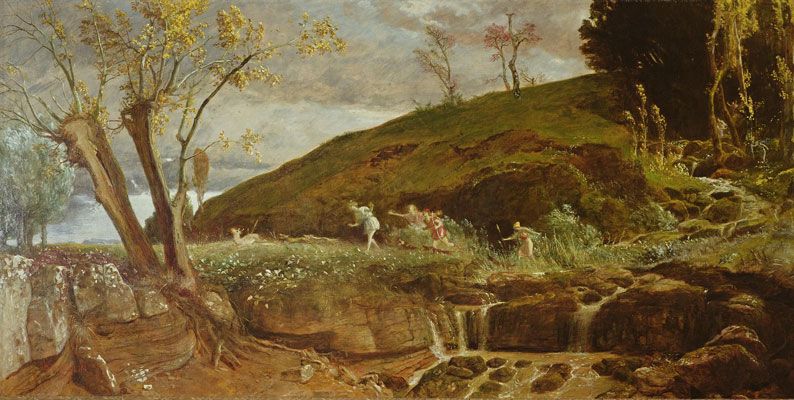
Diana's Hunt
Throughout his career, Böcklin returned again and again to mythological subjects. The inspiration for this work is an episode from the Roman poet Ovid's Metamorphoses, when, during the course of a hunt, the hero Actaeon becomes lost, surprising the goddess Diana as she bathes nude in a pool of water. Outraged, Diana transforms Actaeon into a stag, and he is hunted down and eaten by his own hounds. Böcklin shows Diana armed with her bow, accompanied by several hunters and dogs, chasing after an already-wounded stag.
The story of Actaeon and Diana had been interpreted by a number of painters since the Renaissance, perhaps most notably Titian in works such as The Death of Actaeon (c. 1559-75). But Böcklin's interpretation of the scene is typically idiosyncratic, even bizarrely comic. The exaggerated, fairy-like delicacy of Diana's posture is not in keeping with traditional representations of the noble woodland goddess, and jars with the brutality of the scene unfolding, which comes across in the pained arch of the deer's back. It is thus a further example of the comic-grotesque aesthetic that Böcklin had honed throughout his career.
Painted a few years before his death, this work also represents a process of sentimental recollection for Böcklin, who was commissioned in his hometown of Basel to create a picture of the same scene, Heroic Landscape (Diana Hunting), in 1858. This late work can be seen as a homage both to the traditions of Renaissance and Neo-classical painting, and to the city of the artist's birth.
Oil on canvas - Musée d'Orsay, Paris
Biography of Arnold Böcklin
Childhood
Arnold Böcklin was born in Basel, Switzerland in 1827 to Christian Frederick Böcklin and Ursula Lippe, named after a character from Friedrich Schiller's 1804 play William Tell. Both of Böcklin's parents were from Northern Switzerland, and his father was a silk trader, an itinerant occupation which perhaps influenced Böcklin's later interest in travel. Böcklin left Switzerland at an early age, studying painting at the Düsseldorf Academy of Art from 1845 to 1847 under the tutelage of the landscape painter Johann Wilhelm Schirmer. Böcklin also studied with the Romantic painter Carl Friedrich Lessing, and was introduced to the work of the Nazarene movement. The coexistence of Neoclassical, Romantic, and Nazarene traditions at Düsseldorf played into Böcklin's own stylistic eclecticism. While at Düsseldorf, he created several paintings of the Swiss Alps, influenced by his Academy tutors and by artists such as Caspar David Friedrich, using dramatic effects of shadow and color to bring out the expressive character of the landscape.
Early Training
1848 marked a critical year in Arnold Böcklin's artistic development, as Schirmer sent him to Antwerp, Brussels, and Paris to continue his training. During his travels, Böcklin was especially inspired by the Romantic artists such as Eugène Delacroix, and by Realist painters of the Barbizon School, including Jean-Baptiste-Camille Corot; he was also captivated by the Baroque painter Peter Paul Rubens. Some of Böcklin's work from this period shows a turn towards Realism, while, according to Susanne Marchand, his landscapes were inspired by his tutors Schirmer and Lessing, and by the Swiss landscape painter Alexandre Calame. On a visit to Geneva, however, Böcklin found Calame's studio confining. He was also scarred by his experiences in Paris in 1848. While many of his contemporaries were moved by the February Revolution, Böcklin was horrified by the bloodshed of the June Days, spending much time watching the transportation of prisoners to execution from his small apartment window. Böcklin returned home from France to Basel, and during 1848-49 served his mandatory time in the Swiss Army. By 1850, however, finding the atmosphere of his home-city stifling, he had moved on again, to Rome.
Böcklin's experiences in Rome were an important catalyst for his evolution as an artist. Exploring the ancient ruins of the city, and immersed in the religious iconography of Renaissance Art and the sensuousness of the Baroque, Böcklin moved away from the Realist idiom of his youth. Following the death of his first fiancée, and an unsuccessful marriage proposal, in 1853 Böcklin also met and married Angela Pascucci, the seventeen-year-old daughter of a Papal Guard. Angela was his life-partner and muse, inspiring many of Böcklin's female nudes. Though the marriage was loving, his parents were not particularly supportive of his choice, and Angela's Catholic family were openly hostile because of Böcklin's Protestant heritage. The couple were unable to settle in Rome until 1862, after the death of one of Angela's aunts, Böcklin's staunchest adversary. This, combined with the fact that Angela gave birth to fourteen children, five of whom died in childhood, along with Böcklin's persistent ill health - the artist almost died of Typhus in 1859 - made the marriage emotionally fraught at times.
From 1856 to 1860, Böcklin and Angela lived in Munich, before returning once more to Basel, where Arnold was appointed to a two-year professorship at the Weimar Academy, on the recommendation of his friend and colleague Franz von Lenbach. Critics have noted that Böcklin's sojourn in Rome during the late 1840s was instrumental in determining the course of his future career. Missing out on crucial early developments in modern art such as the emergence of Impressionism in France, Böcklin had instead immersed himself in the work of the Renaissance Masters, and would never be entirely comfortable identifying himself as a modern artist.
Mature Period
From the mid-1860s onward, Böcklin spent the majority of his time in Rome, becoming ever more absorbed in ancient mythology which formed the thematic core of Renaissance art, identifying the morals and principles of these narratives as the basis of human civilization. According to Böcklin's student, the painter Rudolf Schick, in 1863 Böcklin studied Raphael's Vatican murals and the Pompeian wall paintings in Rome, and "the impression was so powerful that he was driven completely out of his previous path", requiring a year to reorient himself towards a new style. Böcklin's newfound appreciation for myth manifested itself in his mature paintings of the 1860s-70s, which, like the work of Symbolist and Pre-Raphaelite artists from the same period, were increasingly preoccupied with the retelling of mythical narrative, often in idiosyncratic and unconventional ways. Art historian Sherwin Simmons notes that, while many viewers initially found Böcklin's work vulgar in its reinterpretation of classical mythology through a personal, even comic lens, "during the 1880s, German critics began to extol him as an artist who had turned away from nature's mere surface appearance and historical trivialities to create a poetic art that resonated with the inner imagination and dreams of the German people." Paintings like Battle of the Centaurs (1873), whose composition and theme are a homage to the famous 1492 marble relief by Michelangelo, were originally frowned on, but grew to be viewed as iconic artworks of the era. Böcklin's popularity also increased due to the circulation of etchings of his paintings by the Berlin-based art-dealer Fritz Gurlitt. These etchings, created on commission by the graphic artist Max Klinger - a significant artist in his own right - were disseminated widely amongst the German middle classes.
Late Period
While Böcklin's most prolific period began in the 1860s, he would not attain fame until the later part his life, with himself and Angela forced to live a frugal lifestyle for most of his career. When success came however, it was on a grand scale, Böcklin becoming one of the best-known artists in Germany by the time of his death. This was partly symptomatic of cultural changes by the end of the nineteenth century, with a new bourgeois class emerging who were less attached to the Neoclassical and academic tastes that still held sway in much of the traditional art market. Böcklin's work sold well with this new audience base, often in the form of reproductions and prints.
Böcklin had been most prolific during the 1860s-80s, but he continued to paint across the last decade of his life, his place in the history of European art confirmed by a major retrospective in Basel in 1897. Art historians such as Pamela Kort and Sherwin Simmons have noted that paintings of Böcklin's such as Playing in the Waves (1883), the subject of a famous critique by the German art critic Julius Meier-Graefe following the exhibition, were seen to have marked a new aesthetic in German art, their curious combination of the sublime and the ridiculous influencing subsequent painters such as Paul Klee.
The Legacy of Arnold Böcklin
Arnold Böcklin died on January 16, 1901 in Fiesole, Italy, having influenced a number of painters of a broadly Symbolist bent, such as Rudolf Schick. The comic-grotesque aesthetic central to Böcklin's work would also become a point of fascination for many later modern artists, influencing the development of German Expressionism, and later French Surrealism, as well the proto-Surrealist painter Giorgio de Chirico; Böcklin also inspired Romantic composers such as Sergei Rachmaninoff. At the same time, Böcklin's painting has not been above reproach, with the melodramatic extravagance of some of his imagery, and its circulation to a large, middle-class audience, seen to have taken him from the world of 'high art' to that of 'mass culture'. Böcklin's work was famously criticized as an example of "kitsch" by the mid-twentieth-century art critic Clement Greenberg, who described it as "one of the most consummate expressions of all that was disliked about the latter half of the nineteenth century."
In her analysis of Böcklin's legacy, the art historian Susanne Marchand notes that unlike the avant-garde artists of the early twentieth century, Böcklin's abandonment of various conventions of academic painting was more by accident than design, a result of his attempts to conflate various painting styles such as Romanticism, Classicism, and Baroque. Indeed, though he is generally grouped together with the Symbolist painters, who also explored mythological imagery with a dreamlike intensity, Böcklin never viewed himself as a modern artist, but as an inheritor and re-worker of the post-Renaissance tradition. It is all the more ironic then, that his posthumous champions included Giorgio de Chirico, Max Ernst, Salvador Dalí, and even Marcel Duchamp.
Influences and Connections

-
![Peter Paul Rubens]() Peter Paul Rubens
Peter Paul Rubens -
![Caspar David Friedrich]() Caspar David Friedrich
Caspar David Friedrich -
![Jean-Baptiste-Camille Corot]() Jean-Baptiste-Camille Corot
Jean-Baptiste-Camille Corot -
![Eugène Delacroix]() Eugène Delacroix
Eugène Delacroix - Johann Wilhelm Schirmer
- Franz von Lenbach
- Alexandre Calame
- Anselm Feuerbach
-
![Baroque Art and Architecture]() Baroque Art and Architecture
Baroque Art and Architecture -
![Neoclassicism]() Neoclassicism
Neoclassicism -
![Romanticism]() Romanticism
Romanticism -
![Realism]() Realism
Realism - Landscape painting
-
![Giorgio de Chirico]() Giorgio de Chirico
Giorgio de Chirico -
![Salvador Dalí]() Salvador Dalí
Salvador Dalí -
![Max Ernst]() Max Ernst
Max Ernst -
![Marcel Duchamp]() Marcel Duchamp
Marcel Duchamp - Lovis Corinth
![Max Klinger]() Max Klinger
Max Klinger- Franz von Lenbach
- Rudolf Schick
Useful Resources on Arnold Böcklin
- Arnold Böcklin, 1827-1901By Katharina Schmidt
- BöcklinBy Hans Dollinger
- The German Expressionists: A Generation in RevoltBy Bernard S. Myers
- Comic Grotesque: Wit and Mockery in German Art, 1870-1940Our PickBy Pamela Kort
- The Visual Arts in Germany, 1890-1937: Utopia and DespairOur PickBy Shearer West
